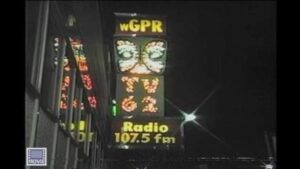Lesson Ideas
Exploring The Role of Radio in launching Genres in Detroit and Nationally
Students should explore the articles below and the discussion guide. Learn more by looking at the images and listening to the original source documents contained in the article. Use the info to discuss and answer the Essential Questions below in class.
Objectives:
- Analyze radio as a form of mass media.
- Describe the effects of radio on the spread of different types of music.
- Formulate opinions on controversial issues in radio.
Introduction
Since its inception, radio’s impact on American culture has been immense. Modern popular culture is unthinkable without the early influence of radio. Entire genres of music that are now taken for granted, such as country and rock, owe their popularity and even existence to early radio programs that publicized new forms of music. Early Proto-Detroit Techno also was promoted by influential Detroit DJs like Duane “In-The-Mix” Bradly, Charles Hicks and the legendary “Electrifying Mojo“. As the art form gained popularity DJ mix shows playing a variety of styles of musical styles like Disco, R&B, Electro, New Wave, and early Hip hop, each on a specific radio station which was defined by a genera became the centerpiece of afternoon and commute time programming and eventually weekend evening programming slots.
Reading 1
Radio and the Development of Popular Music
“One of radio’s most enduring legacies is its impact on music. Before radio, most popular songs were distributed through piano sheet music and word of mouth. This necessarily limited the types of music that could gain national prominence. Although recording technology had also emerged several decades before radio, music played live over the radio sounded better than it did on a record played in the home. Live music performances thus became a staple of early radio. Many performance venues had their own radio transmitters to broadcast live shows—for example, Harlem’s Cotton Club broadcast performances that CBS picked up and broadcast nationwide…
Radio networks mainly played swing jazz, giving the bands and their leaders a widespread audience. Popular bandleaders including Duke Ellington, Benny Goodman, and Tommy Dorsey and their jazz bands became nationally famous through their radio performances, and a host of other jazz musicians flourished as radio made the genre nationally popular (Wald, 2009)…
In the 1940s, other Southern stations also began playing rhythm and blues records recorded by Black artists. Artists such as Wynonie Harris, famous for his rendition of Roy Brown’s “Good Rockin’ Tonight,” were often played by White disc jockeys who tried to imitate Black Southerners (Laird, 2005). During the late 1940s, both Memphis, Tennessee’s WDIA and Atlanta, Georgia’s WERD were owned and operated by Black individuals. These disc jockeys often provided a measure of community leadership at a time when few Black individuals were in powerful positions (Walker)….
The exposure of radio also led to more rapid turnover in popular music. Before radio, jazz bands played the same arrangement for several years without it getting old, but as radio broadcasts reached wide audiences, new arrangements and songs had to be produced at a more rapid pace to keep up with changing tastes (Wald)…
Television, much like modern popular music, owes a significant debt to the Golden Age of Radio. Major radio networks such as NBC, ABC, and CBS became—and remain—major forces in television, and their programming decisions for radio formed the basis for television. Actors, writers, and directors who worked in radio simply transferred their talents into the world of early television, using the successes of radio as their models. (Media and Culture- University of Minnesota)
Reading 2
The early history of WGPR in Detroit
(3146 E Jefferson Ave, Detroit, MI 48207)
 DETROIT — A radio station that’s “kinda movin’ ” gets listeners and WGPR-FM is a station constantly on the move. Floyd M. Jones, station manager, said the station is “No. 1 among FM stations and No. 3 among stations – period.”
DETROIT — A radio station that’s “kinda movin’ ” gets listeners and WGPR-FM is a station constantly on the move. Floyd M. Jones, station manager, said the station is “No. 1 among FM stations and No. 3 among stations – period.”
Probably the strongest example of how this station moves, however, is a countdown of its remotes – 36 a week. Jones handles a two-hour daily, three–hour Saturday evening jazz record show from the Disk Jockey Lounge. Dan (Bull Frog) Harrison does a rhythm and blues record show from the Chit Chat Lounge. DJ Larry Dixon may handle a random remote broadcast, but nothing steady at the moment; however, he does have a weekly record hop.
The 50,000-watt FM station broadcasts about 20 hours a day covering a radius of 75 miles. One reason for the tremendous success enjoyed by the station, Jones said, is that some 87 percent of Detroit’s Negro element has FM radios. “But it’s more than that. We’re creating the image here that FM is more than just a background medium. We’re putting out a new sound.”
While the station programs record shows for Detroit populace such as Greeks, Italians, Polish and Mexican, the main portion of each day is used with rhythm and blues programs – a total of three programs a day for a total of seven hours. Jazz takes up about four hours each day. Gospel music is played early in the morning. Sunday is devoted to remote broadcasts most of the day from local churches. The station employs about 40 people. Bob Longwell is the station’s general manager.
Another reason the station is moving, according to Jones, is that programming and air personalities aims at three important and large audience segments. “I take care of the jazz fans,” Jones said. “Larry Dixon is a teen-oriented personality. And Bullfrog is for the rhythm and blues fans.” (Information and news source: Billboard; July 17, 1965 via https://www.mcrfb.com/?cat=50)
Activities:
- Students will listen to and explore primary source recordings of radio shows with current radio programming and the offering of streaming services.
- The student will listen to commentary on Detroit as a “test market” for artists to be played, prior to national radio distribution and discuss why the diverse “sounds” made Detroit a perfect incubator for new genres like Techno to emerge from.
Listen to WGPR broadcasts:
The Electrifying Mojo Rare Moments
Essential Questions:
- What role did record stores play in the spread of genres?
- What are the modern equivalents of the record store?
- Do modern equivalents to record stores serve the same functions in spreading info about music?
- What year did the infamous dance music TV show “The Scene” debut on WGPR in Detroit? (See the Detroit Techno Timeline)


